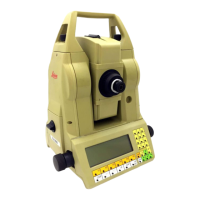
Do you have a question about the Leica TPS 1000 Series and is the answer not in the manual?
| Brand | Leica |
|---|---|
| Model | TPS 1000 Series |
| Category | Security System |
| Language | English |
Indicates an imminently hazardous situation resulting in death or serious injury if not avoided.
Indicates a potentially hazardous situation or unintended use resulting in death or serious injury if not avoided.
Indicates a potentially hazardous situation or unintended use resulting in minor injury and/or appreciable damage if not avoided.
Important paragraphs for technically correct and efficient product use.
Section for retaining part 1 for records and returning part 2 for registration.
Complete and return part 2 promptly to ensure eligibility for software support.
Details on the support provided by Leica for software corrections and modifications.
Introduction to TPS 1000 as a positioning system integrating computerization and total station technology.
Offers functionality, flexibility, large display, convenient input, removable data storage, and onboard applications.
Motorized and ATR versions enhance productivity for repetitive tasks and stake-out.
Diagram and list of components for the T-Version instrument.
Diagram and list of components for the TM-Version instrument.
Diagram and list of components for the TC-Version instrument.
Diagram and list of components for the TCM-Version instrument.
Diagram and list of components for the TCA-Version instrument, including EGL1 Guide light option.
Remove instrument from transport case and check for completeness.
Instructions for charging batteries using GKL chargers and relevant warnings.
Precautions for theodolite version, including removing protective cover before fitting EDM.
Recommendations for using GPH1 prism holder and aiming at the reflector's centre.
Procedure for switching on the instrument and initial display sequence.
Graphical and numerical display of instrument tilt for precise leveling.
Steps to install and select the EDM type in system configuration.
How to use the MEASURE MODE (GSI) dialog for measurements.
Division of TPS1000 software into system and applications software.
Storing measurement data on SRAM memory card and directory structure.
Describes normal operation and remote operation via serial interface.
Overview of display areas, key groupings, and graphical display resolution.
Explanation of different dialog types used in the TPS1000.
Functions of the white fixed keys that bypass operation sequence.
Keys for inputting numerical values, decimal points, signs, and confirming selections.
Significance of the main menu for starting functions and applications.
Fundamental importance of the measurement dialog for entering data and covering requirements.
Entering target point number, remarks, prism constants, and corrections.
Function for displaying, deleting data, editing points, codes, and remarks.
Entering point coordinates into the data file.
Displaying data point by point according to the recording template.
Recommended prism holder (GPH1A) for short-distance measurements with attachable EDMs.
Details on the GRZ4 reflector and its advantages for automatic target recognition.
Information on Leica retro tapes for monitoring and special features.
Switching instrument to a mode for communication with data recorder or PC via RS232 interface.
Procedure for formatting the memory card, including data loss warning.
Setting the system date and time according to general rules and specific keys.
Defining the range of functions available and customizing settings like menus and ppm definitions.
Adjusting settings to match survey application requirements, defining up to five user templates.
Explains TCA models can be remote-controlled from the prism region for solo surveys.
Describes how to put standard TCPS25 radio modems into operation.
Key allocation on RCS 1000 is same as TPS1000; functions serve to target TPS1000 on prism.
Turns the EGL1 guide light ON or OFF, intensity adjustable for light conditions.
Mentions general mechanical errors and the need for redetermination.
Determination of index error for longitudinal and transverse axes of the compensator.
Determination of the zero-point error of the vertical encoding circle.
Determination of the divergence of the line of sight from the tilting axis.
Guidelines for dispatching and carrying the instrument, including packaging recommendations.
Instructions for cleaning lenses, prisms, PCMCIA cards, cables, and plugs.
Information on charging procedures, times, and compatibility for GKL22 and GKL23 chargers.
Recommendations for using GKL12 and GKL14 chargers and initial battery charging procedures.
Describes the data structure and organization of the Leica GSI interface.
Choice of GSI formats with word lengths of 8 and 16 characters and special conditions.
Data transmitted by instruments over GSI interface is composed of blocks (measurement and code blocks).
Permitted uses of TPS-System 1000 electronic theodolites and total stations.
Lists uses that are not permitted and can lead to hazards or damage.
Danger of electrocution from reflector poles near electrical installations.
Accuracy specifications for angle measurements across different instrument types (e.g., 1100, 1500, 1700, 1800, 2003).
Range specifications based on atmospheric conditions and prism types.
Details on compensator type, number of axes, setting range, and accuracy.
List of available application programs and their features (e.g., Coordinate display, Orientation, Stakeout).
Charts for atmospheric correction in ppm based on temperature, pressure, and humidity.